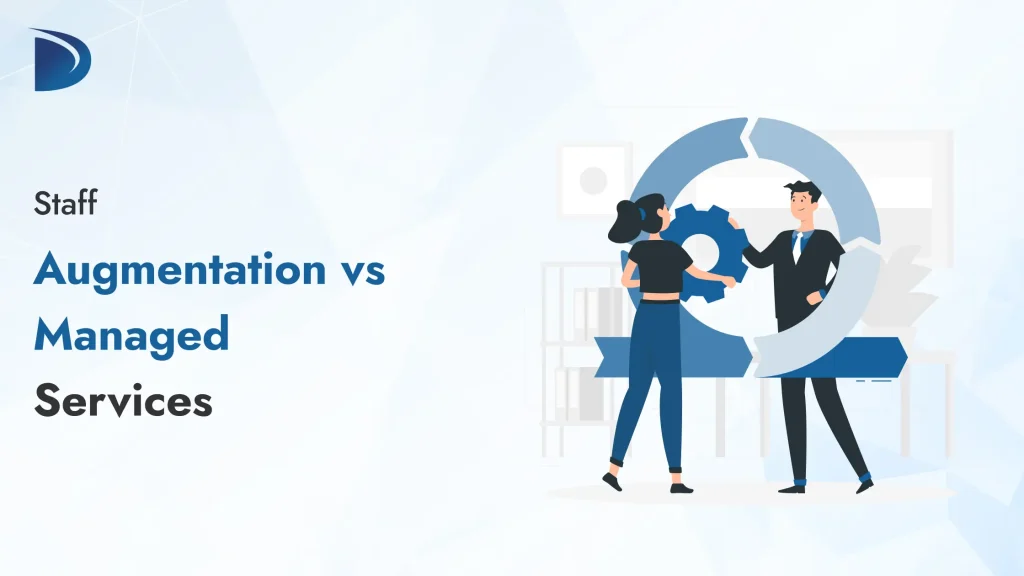Table of Contents
Companies often need extra help to complete projects, meet deadlines, or bring in specific skills. Instead of hiring full-time employees, many choose between three popular models: staff augmentation, managed services, and outsourcing. Each approach offers different levels of control, cost, and responsibility.
Understanding the differences between staff augmentation vs managed services or even staff augmentation vs outsourcing can help you make the right choice based on your team’s size, goals, and budget.
What is staff augmentation?
Staff augmentation is when a company temporarily adds skilled professionals from an outside source to its existing team. These professionals work under the company’s guidance and are treated like part of the internal team, but they are not full-time employees.
Benefits of Staff Augmentation:
- Flexibility: Add or reduce team members quickly based on project needs.
- Cost-effective: Pay only for the time and skills you need—no long-term contracts or employee benefits required.
- Full control: You manage the project, tasks, and priorities as if the augmented staff were your own.
Challenges:
- Onboarding needed: Temporary workers need time to learn your tools, systems, and workflows.
- Team alignment: Extra effort may be needed to build team chemistry between internal and external members.
Ideal for:
- Short-term projects
- Quick skill gap filling
- Teams that want full control over their work
What are managed services?
Managed services involve handing over part or all of a business function to a third-party provider. Unlike staff augmentation, the provider is responsible for managing the team, process, and final outcome. This model works well for long-term functions such as IT support, cybersecurity, or cloud management.
Benefits of Managed Services:
- Expert support: Access experienced professionals with specialized skills.
- Focus on core work: Your in-house team can concentrate on strategic goals while the service provider handles routine operations.
- Predictable costs: Managed services usually come with fixed monthly or annual fees, making budgeting easier.
Challenges:
- Less control: Since the provider manages the work, you may have less influence over daily operations.
- Provider reliability: Your business relies on the provider’s consistency and service quality.
Ideal for:
- Ongoing or repetitive tasks (e.g., IT support, system monitoring)
- Businesses needing specialized expertise
- Companies looking to reduce internal workload
What is outsourcing?
Outsourcing is a broader term that means sending any type of work to an external company. It could be a full department (like customer service or accounting) or a one-time project (like app development or digital marketing).
Outsourcing gives you access to external teams, often in other countries, which can help reduce costs and speed up delivery.
Benefits of Outsourcing:
- Lower costs: Especially when outsourcing to countries with lower labor costs.
- Faster results: Experienced teams often have ready-made processes.
- No in-house pressure: Outsourcing frees your internal team from extra work.
Challenges:
- Time zone differences: Can make communication slower.
- Cultural/language gaps: May affect work quality or understanding of business goals.
- Quality control: Harder to oversee work when the team is fully external.
Ideal for:
- One-off or large projects
- Non-core business functions
- Companies looking to scale quickly
Staff Augmentation vs Managed Services: Key Differences
When comparing staff augmentation vs managed services, the key difference is control and ownership. In staff augmentation, you manage the people and tasks. In managed services, the provider manages everything based on your agreement.
Feature Staff Augmentation Managed Services Who manages the work? Your internal team The service provider Level of control High Low to medium Duration Short to mid-term Long-term Cost model Hourly or daily rates Fixed or subscription pricing Use case Skill gaps, extra manpower Full-function management (e.g., IT, QA)
If you need people to help your team for a limited time, go for staff augmentation. If you want someone else to fully manage a part of your business, choose managed services.
Staff Augmentation vs Outsourcing: What’s the Difference?
Staff augmentation vs outsourcing can also be confusing. The main difference is that staff augmentation blends into your team, while outsourcing works separately from your company.
Feature Staff Augmentation Outsourcing Team integration Works within your team Separate external team Communication flow Direct and regular Limited, depending on agreement Control over tasks High-Low Skill Focus Specific talent General project execution Ideal for Temporary support Full projects or departments
Choose staff augmentation when you want help inside your team. Choose outsourcing when you want someone to handle a full task or project outside your company.
How to Choose the Right Model?
Here are a few tips to help you decide between staff augmentation vs. managed services or staff augmentation vs outsourcing:
- Need control? Choose staff augmentation.
- Want experts to fully manage a process? Go with managed services.
- Need a project done with little internal involvement? Pick outsourcing.
- Working on a short-term or fast-moving project? Staff augmentation is ideal.
- Need long-term support or operations handling? Managed services or outsourcing may suit better.
Conclusion
Choosing between staff augmentation vs managed services or comparing staff augmentation vs outsourcing depends on your business needs, team structure, and how much control you want. All three models offer valuable benefits but the right choice can save time, reduce cost, and boost results.
Whether you’re filling short-term skill gaps with staff augmentation, offloading responsibilities through managed services, or handing off entire projects via outsourcing, understanding the difference helps you make smart, strategic decisions for your company.

